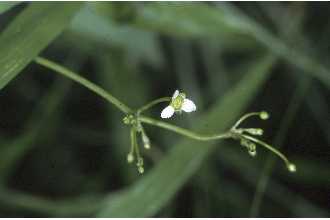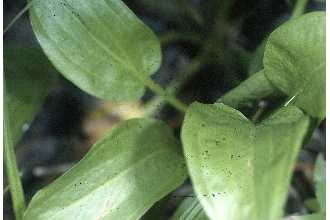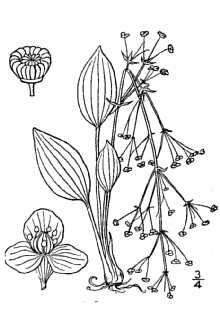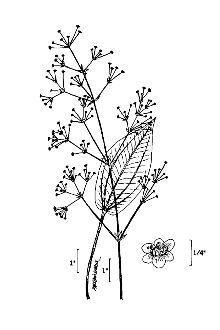Alisma plantago-aquatica L. ssp. subcordatum (Raf.) Hultén
Scientific Name: Alisma plantago-aquatica L. ssp. subcordatum (Raf.) Hultén

| General Information | |
|---|---|
| Usda Symbol | ALPLS |
| Group | Monocot |
| Life Cycle | Perennial |
| Growth Habits | Forb/herb |
| Native Locations | ALPLS |
Plant Guide
Use a soil moisture meter to monitor the soil moisture where Alisma plantago-aquatica L. ssp. subcordatum (Raf.) Hultén is planted.
Fact Sheet
Alternate Names
Alisma plantago-aquatica L. ssp. subcordatum(Raf.) Hultén
Uses
Waterfowl and upland birds readily consume the seed of this broadleaf species, but the roots have not been observed to be eaten. Its small white and yellow flower are attractive, having potential use in water gardens.
Status
Please consult the PLANTS Web site and your State Department of Natural Resources for this plant’s current status (e.g. threatened or endangered species, state noxious status, and wetland indicator values).
Description
This light to yellow green, erect herbaceous perennial can reach heights of about 3 feet. The ovate to lanceolate shaped leaves emerge from a 1 1/4 to 6 inch long stem. Each leaf has a primary mid-vein which is flanked by three subparallel veins. Leaf stems emerge from bulb-like corms which have shallow fibrous roots. Vegetative spread is slow and radial. This species relies on population spread by seed. Independent, single or multiple, whorl branched inflorescence rise from the plant base to a height of 3 1\2 feet. White to pinkish 3 petaled flowers bloom from June to September on compound panicles. Numerous flat, keeled, achenes form terminally in tight rings, mature from July to October. Seedlings will emerge on exposed soils, in stands of existing vegetation or newly disturbed locations. Robert H. Mohlenbrock USDA, NRCS 1995 Northeast Wetland Flora @USDA NRCS PLANTS
Adaptation and Distribution
Distribution
Distribution
The native range of water plantain is from Massachusetts to Minnesota, south to Florida and Texas, This broadleaf emergent can be found growing in shallow, quiet to slow moving water, and in mud of marshes, ponds, lakes, streams, ditches, and seeps, It requires organic or silty soils, with seasonally or permanently inundated freshwater (<0,5 parts per thousand salt content), To grow optimally, it requires full sunlight, For a current distribution map, please consult the Plant Profile page for this species on the PLANTS Website, , Use soil moisture sensors to measure the soil moisture of Alisma plantago-aquatica L. ssp. subcordatum (Raf.) Hultén.
Establishment
This species can be established effectively by vegetative divisions or seed. Bare-root or containerized vegetative propagules are used to effectively establish plantain within its hydric regime. It is easy to handle this form of material due to its small size, ease of separation, and plantability. On site and nursery seedings are not as predictable; water plantain requires specific after ripening, stratification, and germination conditions before emergence will occur. Once established onto a site with ideal hydrology, this species will continue to re-seed itself for as long as the ideal environmental conditions exist. Ideal sites for germination require direct sunlight, finely textured soils, and adequate sustained soil moisture.
Management
On manageable sites, water depths must be kept moist to flooded (<4 inches) for the growing season. In early spring, water depths must recede, exposing seeds to bare soil to germinate. This species responds well to low to moderate levels of fertilizer amendments; naturally released nutrients from sediments and organics are usually adequate for good plant growth.
Plant Traits
Growth Requirements
| Temperature, Minimum (°F) | -33 |
|---|---|
| Adapted to Coarse Textured Soils | No |
| Adapted to Fine Textured Soils | Yes |
| Adapted to Medium Textured Soils | Yes |
| Anaerobic Tolerance | High |
| CaCO3 Tolerance | Medium |
| Cold Stratification Required | Yes |
| Drought Tolerance | None |
| Fertility Requirement | Medium |
| Fire Tolerance | High |
| Frost Free Days, Minimum | 90 |
| Hedge Tolerance | None |
| Moisture Use | High |
| pH, Maximum | 7.0 |
| pH, Minimum | 5.0 |
| Planting Density per Acre, Maxim | 4800 |
| Planting Density per Acre, Minim | 1700 |
| Precipitation, Maximum | 60 |
| Precipitation, Minimum | 35 |
| Root Depth, Minimum (inches) | 8 |
| Salinity Tolerance | None |
| Shade Tolerance | Intolerant |
Morphology/Physiology
| After Harvest Regrowth Rate | Slow |
|---|---|
| Toxicity | None |
| Resprout Ability | No |
| Shape and Orientation | Erect |
| Active Growth Period | Spring and Summer |
| Bloat | None |
| C:N Ratio | Medium |
| Coppice Potential | No |
| Fall Conspicuous | No |
| Fire Resistant | No |
| Flower Color | White |
| Flower Conspicuous | Yes |
| Foliage Color | Green |
| Foliage Porosity Summer | Porous |
| Foliage Porosity Winter | Porous |
| Fruit/Seed Color | Brown |
| Nitrogen Fixation | None |
| Low Growing Grass | No |
| Lifespan | Moderate |
| Leaf Retention | No |
| Known Allelopath | No |
| Height, Mature (feet) | 0.5 |
| Growth Rate | Moderate |
| Growth Form | Single Crown |
| Fruit/Seed Conspicuous | No |
| Foliage Texture | Medium |
Reproduction
| Vegetative Spread Rate | None |
|---|---|
| Small Grain | No |
| Seedling Vigor | Medium |
| Fruit/Seed Period Begin | Summer |
| Seed Spread Rate | Moderate |
| Seed per Pound | 825000 |
| Propagated by Tubers | No |
| Propagated by Sprigs | Yes |
| Propagated by Sod | No |
| Propagated by Seed | Yes |
| Propagated by Corm | No |
| Propagated by Container | No |
| Propagated by Bulb | No |
| Propagated by Bare Root | Yes |
| Fruit/Seed Persistence | No |
| Fruit/Seed Period End | Summer |
| Fruit/Seed Abundance | Medium |
| Commercial Availability | Routinely Available |
| Bloom Period | Late Spring |
| Propagated by Cuttings | No |
Suitability/Use
| Veneer Product | No |
|---|---|
| Pulpwood Product | No |
| Post Product | No |
| Palatable Human | No |
| Nursery Stock Product | No |
| Naval Store Product | No |
| Lumber Product | No |
| Fodder Product | No |
| Christmas Tree Product | No |
| Berry/Nut/Seed Product | No |



